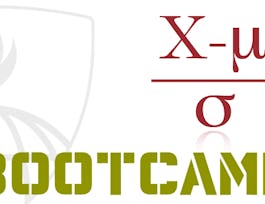Calculus through Data & Modeling: Differentiation Rules continues the study of differentiable calculus by developing new rules for finding derivatives without having to use the limit definition directly. These differentiation rules will enable the calculation of rates of change with relative ease the derivatives of polynomials, rational functions, algebraic functions, exponential and logarithmic functions, and trigonometric and inverse trigonometric functions. Once these rules are developed, they are then applied to solve problems involving rates of change and the approximation of functions.



Calculus through Data & Modeling: Differentiation Rules
This course is part of Differential Calculus through Data and Modeling Specialization

Instructor: Joseph W. Cutrone, PhD
Top Instructor
Sponsored by BrightStar Care
3,340 already enrolled
(67 reviews)
Skills you'll gain
Details to know

Add to your LinkedIn profile
6 assignments
See how employees at top companies are mastering in-demand skills

Build your subject-matter expertise
- Learn new concepts from industry experts
- Gain a foundational understanding of a subject or tool
- Develop job-relevant skills with hands-on projects
- Earn a shareable career certificate


Earn a career certificate
Add this credential to your LinkedIn profile, resume, or CV
Share it on social media and in your performance review

There are 7 modules in this course
In previous course, we defined and calculated the derivative as a limit. In this module, we will examine the derivatives of some important functions, including polynomials, exponentials, logarithms, and trigonometric functions. We will also learn differentiation rules which will help us to compute derivatives more efficiently. Finally, we will generalize the idea of a derivative to multivariable functions, and learn how to find derivatives and rates of change on a graph in space.
What's included
3 videos1 reading1 assignment
The formulas of this section enable us to differentiate new functions formed from old functions by multiplication or division.
What's included
2 videos1 reading1 assignment
Before starting this module, please review trigonometric functions, in particular their graphs. In this module, we will develop formulas to find derivatives for the common trigonometric functions of sine and cosine. Together with the product and quotient rules, the derivatives for the remaining trigonometric functions are formulated. These new derivative formulas are then added to our catalog to use and apply to solve problems related to rates of change.
What's included
2 videos1 reading1 assignment
Many functions are created through composition of other functions. In this module, one of the most important of the differentiation rules of this course is developed which will allow us to find derivatives of the compositions of functions. This rule is called the chain rule and has a variety of applications.
What's included
1 video1 reading1 assignment
In this module, the notion of the derivative is applied to multivariable functions through the notion of partial derivatives. Algebraic rules are developed to find partial derivatives of multivariable functions as well as their geometric interpretations. The development of the tools of calculus to multivariable functions allows for further analysis of more complicated data sets.
What's included
1 video2 readings1 assignment
In this module, we continue the application of partial derivatives to find rates of changes in any direction by developing the theory of directional derivatives and gradient vectors. These new tools of multivariable calculus can then be applied to problems in economics, physics, biology, and data science.
What's included
1 video2 readings1 assignment
Apply the theory of this course to model a flight path for a landing aircraft.
What's included
1 peer review
Instructor

Offered by
Why people choose Coursera for their career




Learner reviews
67 reviews
- 5 stars
87.14%
- 4 stars
10%
- 3 stars
1.42%
- 2 stars
1.42%
- 1 star
0%
Showing 3 of 67
Reviewed on Mar 3, 2024
I found the first course in the specialization a lot harder than this one to be honest
Reviewed on Oct 1, 2021
amazing course with tons of concrete examples, great lecturer, very clear teaching, would highly recommend to anyone who want to learn calculus
Reviewed on Jun 1, 2021
This is a great course. Instructor is amazing and goes through a large number of examples.
Recommended if you're interested in Math and Logic

Johns Hopkins University

University of California, Irvine

University of Colorado Boulder

DeepLearning.AI

Open new doors with Coursera Plus
Unlimited access to 10,000+ world-class courses, hands-on projects, and job-ready certificate programs - all included in your subscription
Advance your career with an online degree
Earn a degree from world-class universities - 100% online
Join over 3,400 global companies that choose Coursera for Business
Upskill your employees to excel in the digital economy


